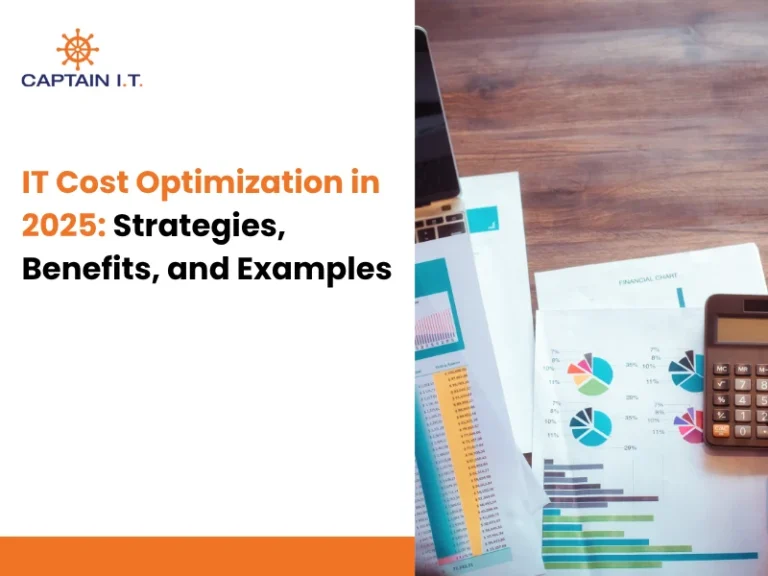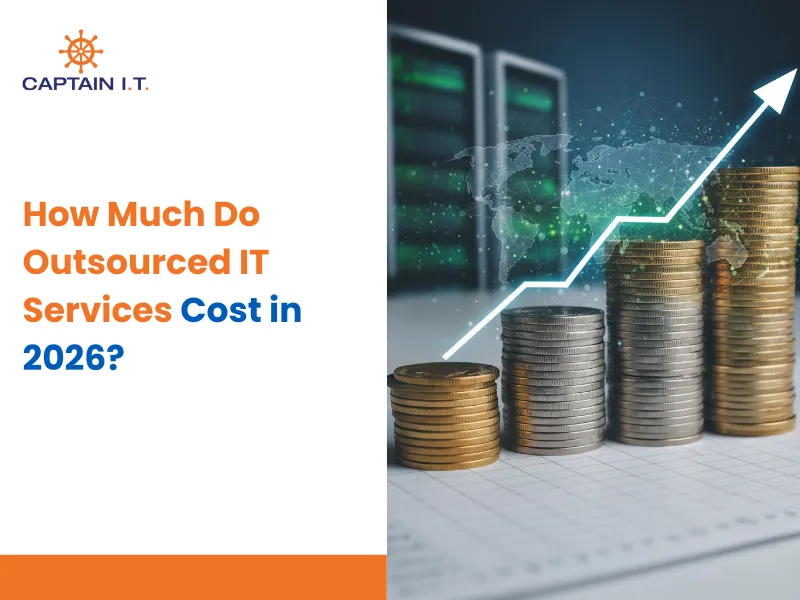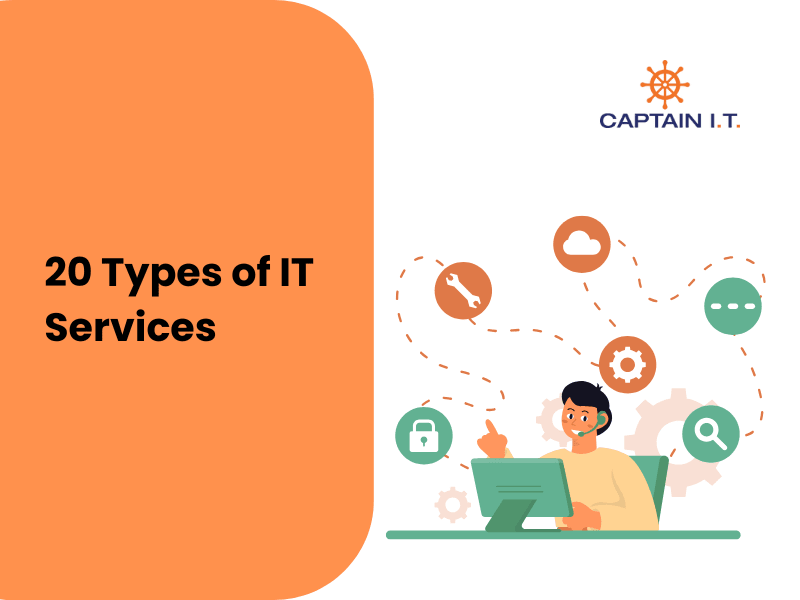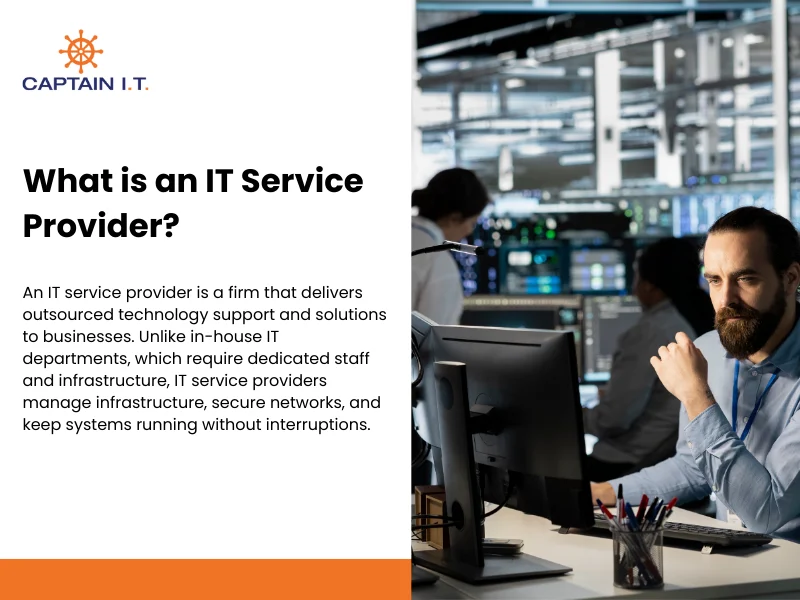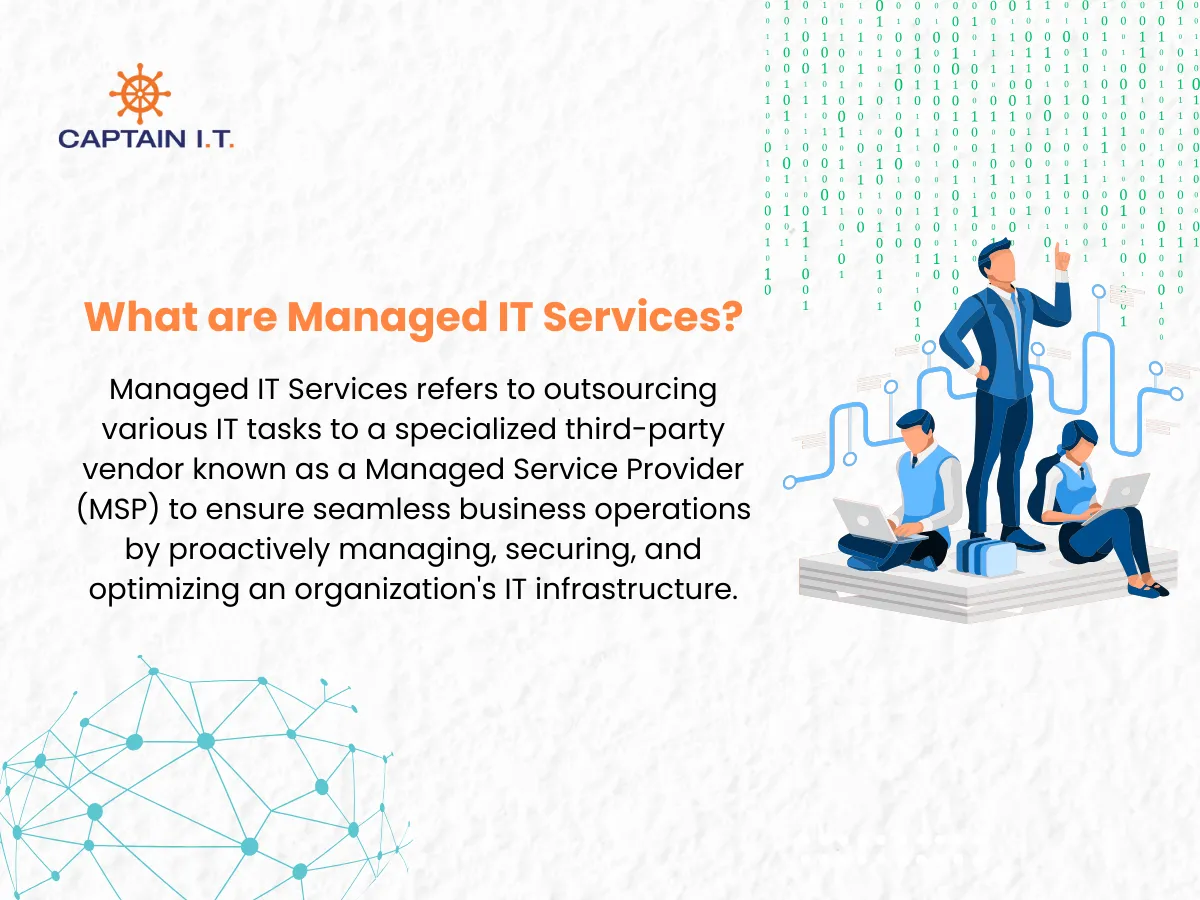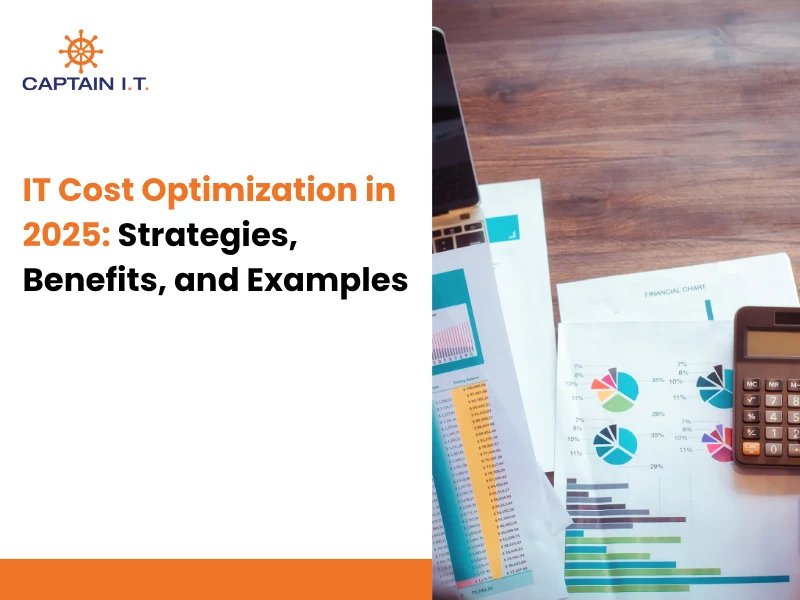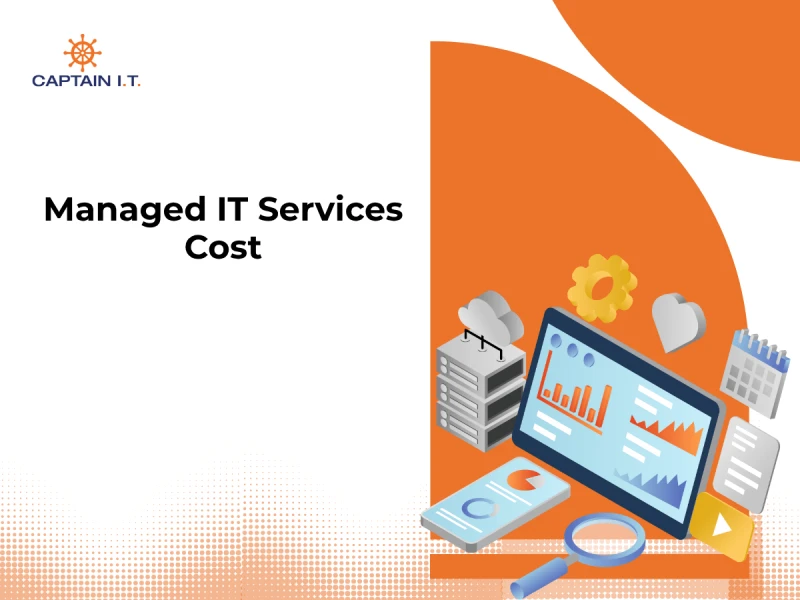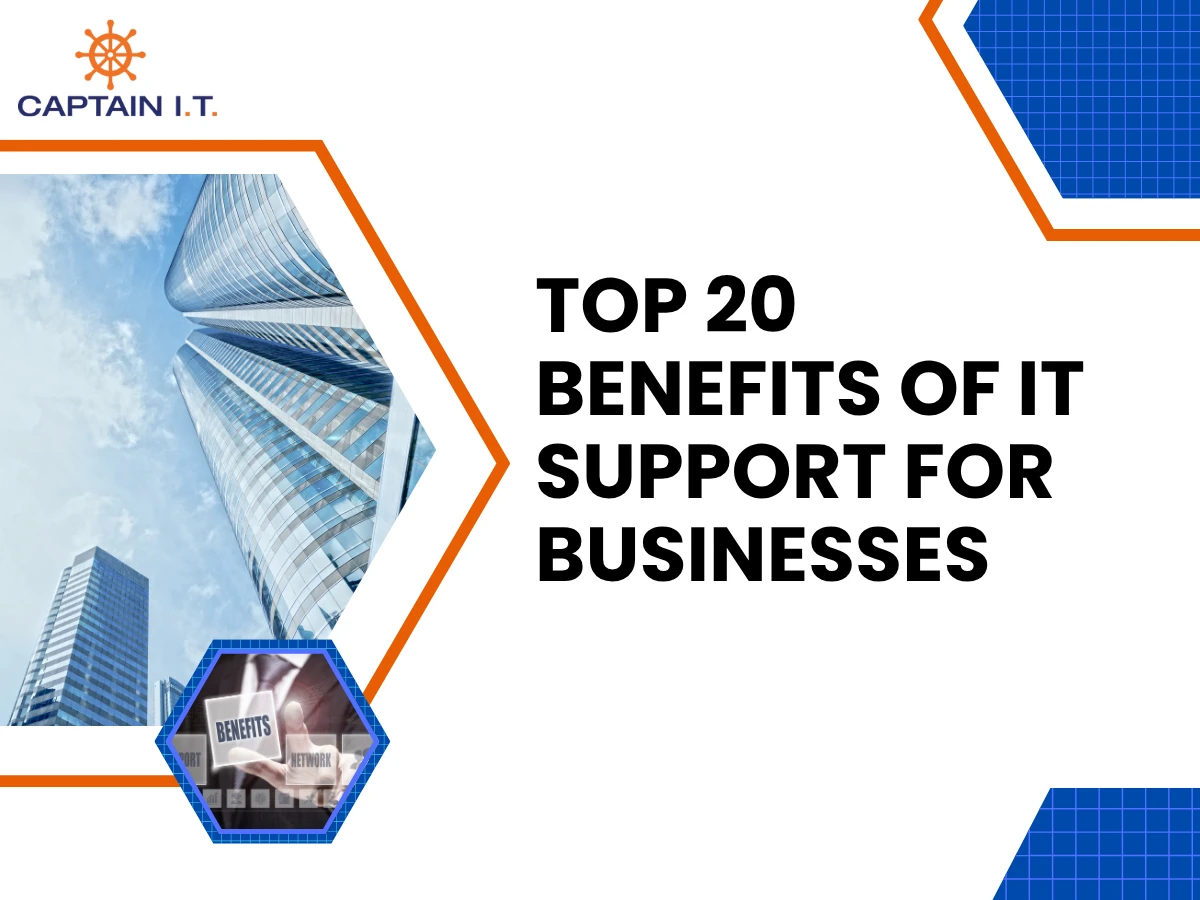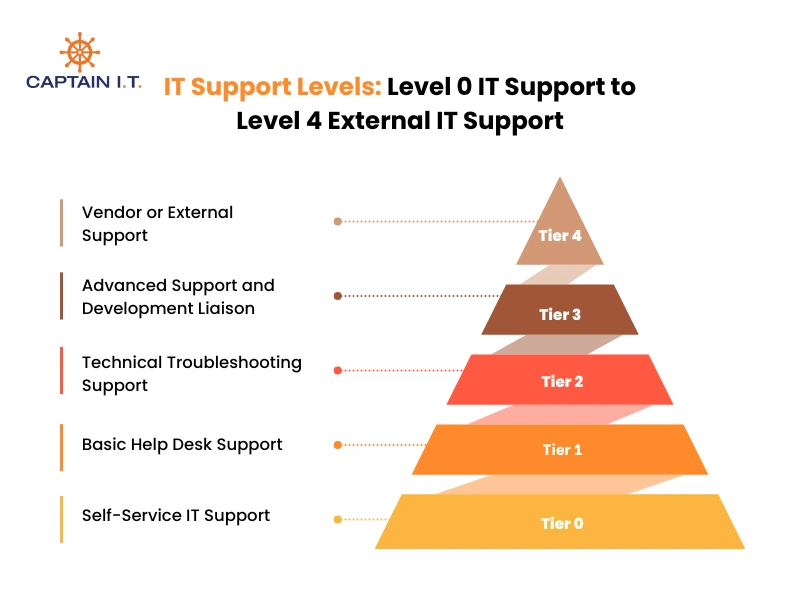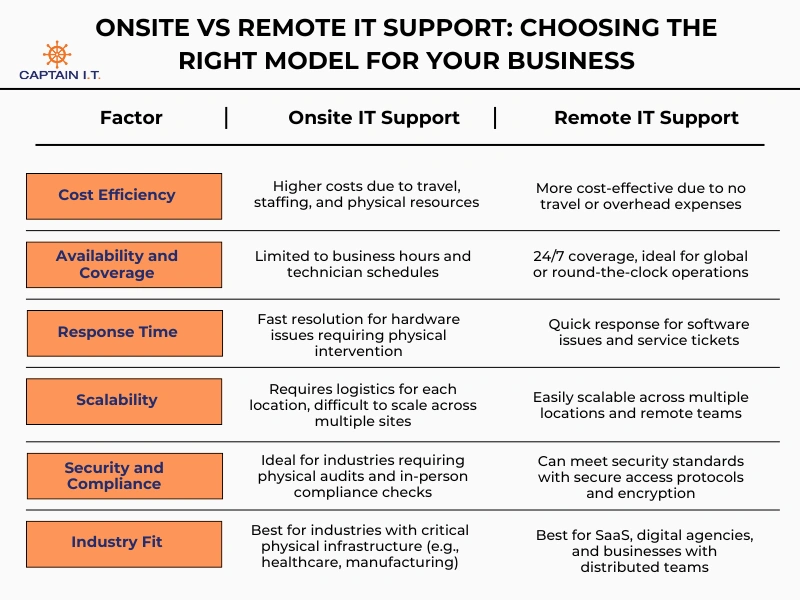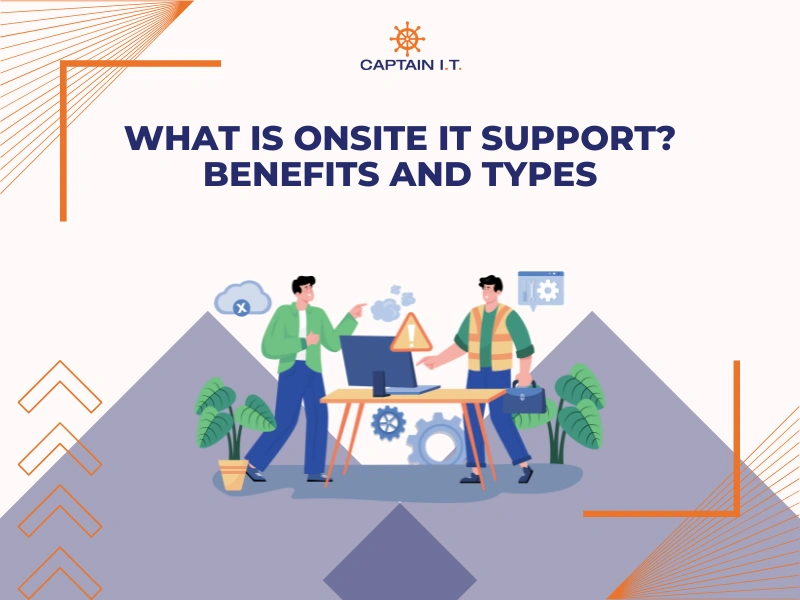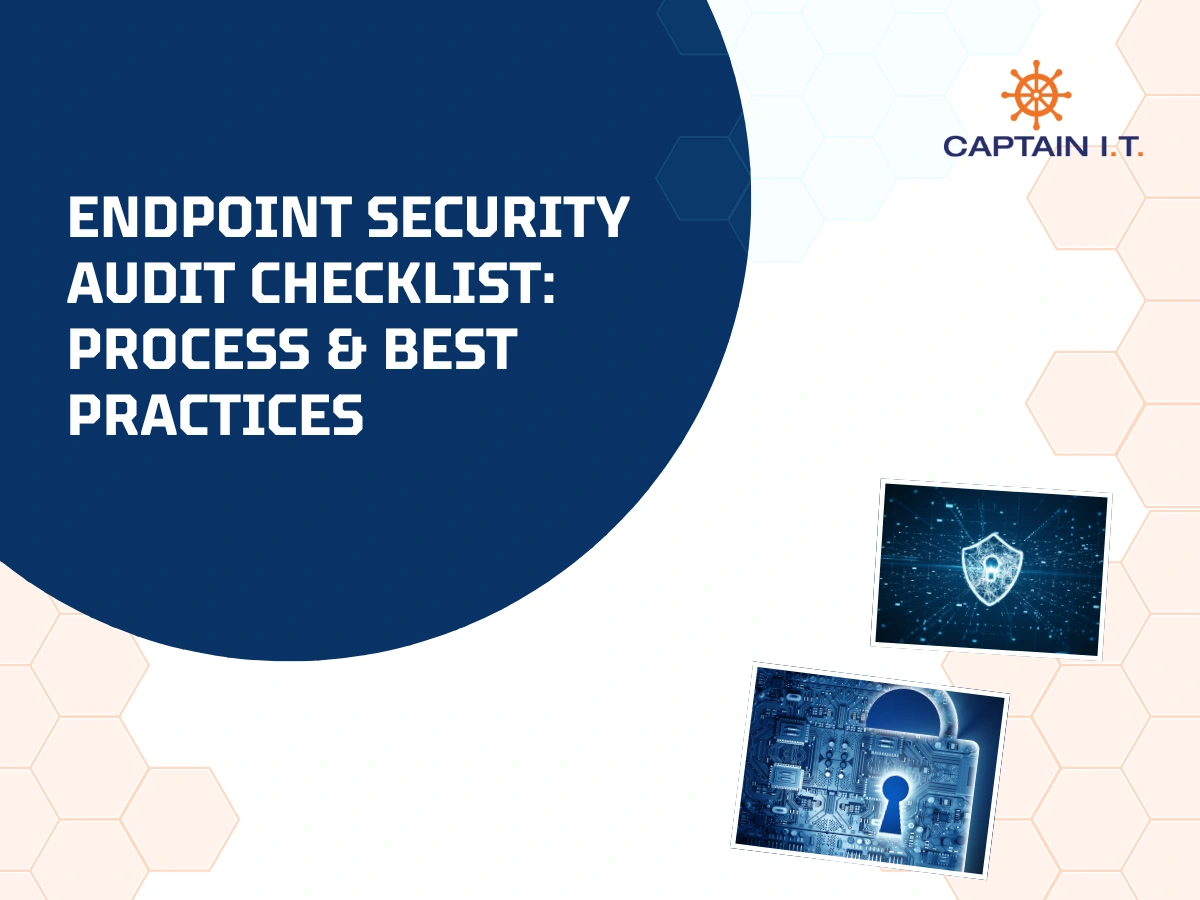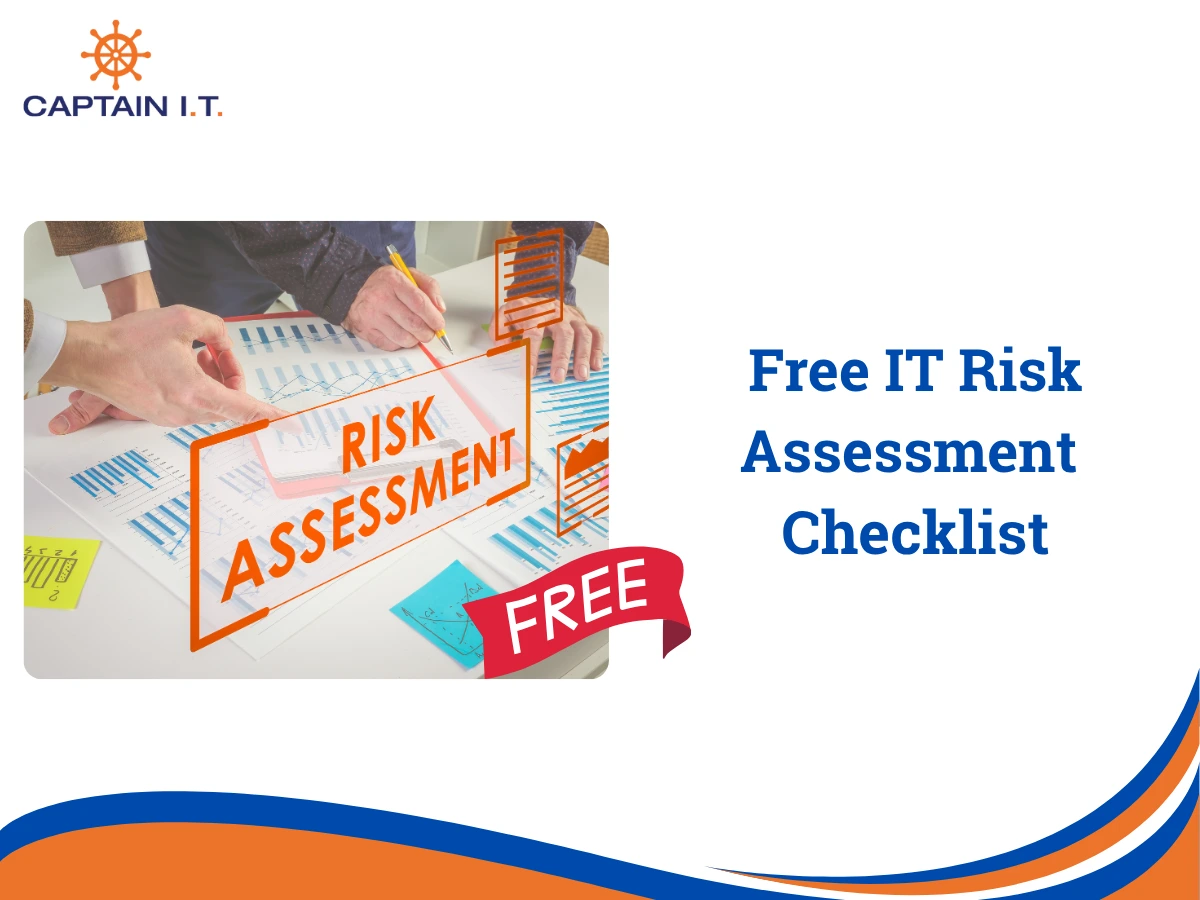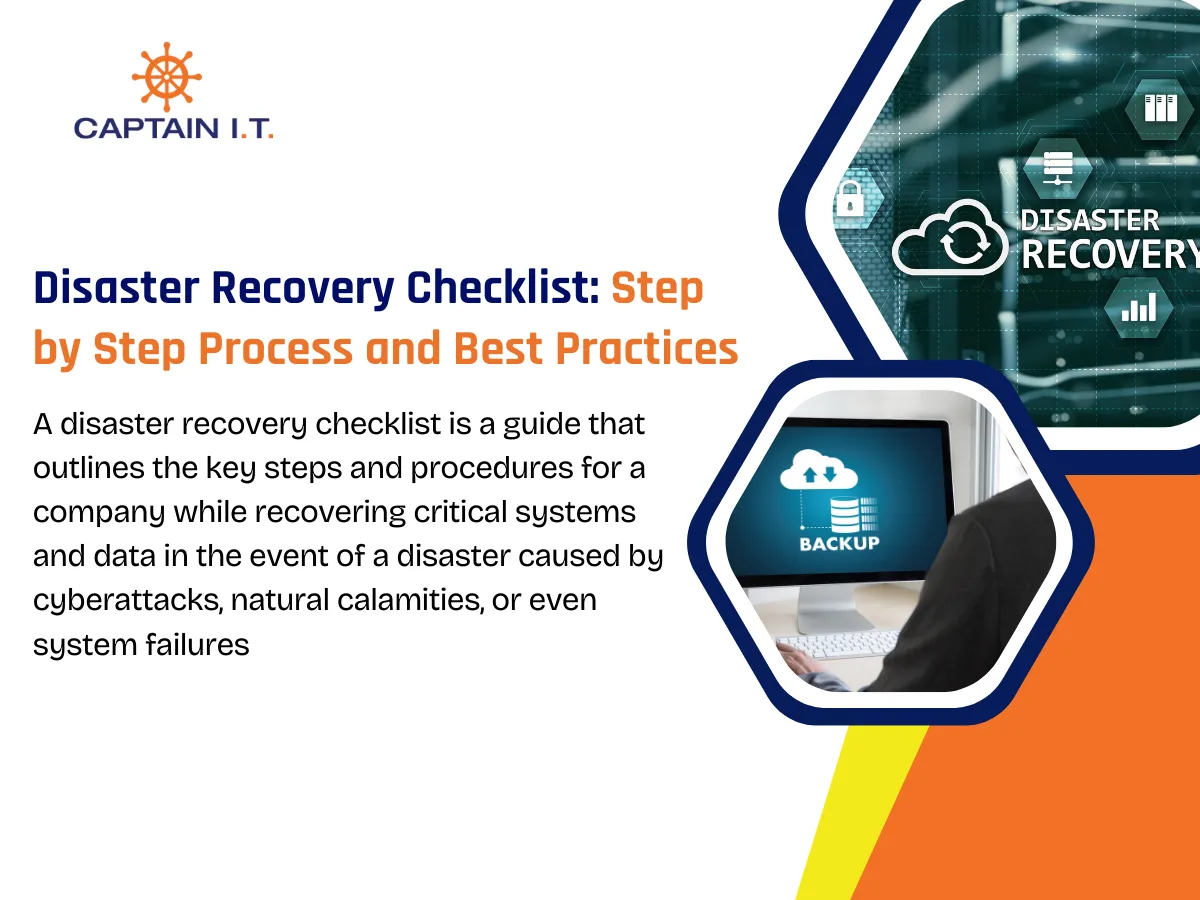As businesses scale their IT infrastructure in 2025, many face rising costs due to underutilized cloud resources, duplicate software licenses, and fragmented technology stacks. Despite a growing digital footprint, operational bottlenecks remain, and business units often operate in silos with separate tools and vendors, leading to uneven value realization. This creates the need for IT cost optimization to ensure resources are aligned with business outcomes.
IT cost optimization addresses this imbalance by focusing on cost visibility, improving resource efficiency, and ensuring value realization. Rather than slashing budgets, the goal is to identify and eliminate waste while maximizing the return on technology investments. Key practices include cloud cost control, license rationalization, process automation, and asset lifecycle management. These strategies help businesses maintain flexibility, reduce redundant spending, and align IT expenses with business needs.
Given the complexity of modern IT environments, many SMBs and enterprises turn to Managed Service Providers (MSPs) for structured support. MSPs streamline vendor management, automate monitoring, and enforce usage policies, providing enhanced visibility across IT operations and driving smarter decision-making and long-term savings.
What is IT Cost Optimization?
IT cost optimization is the process of reducing IT expenses while maximizing value, performance, and efficiency. Unlike cost reduction, which focuses solely on cutting budgets, it aims to balance cost savings with enhanced performance. By aligning IT spending with business goals, IT cost optimization ensures that every dollar contributes to long-term value.
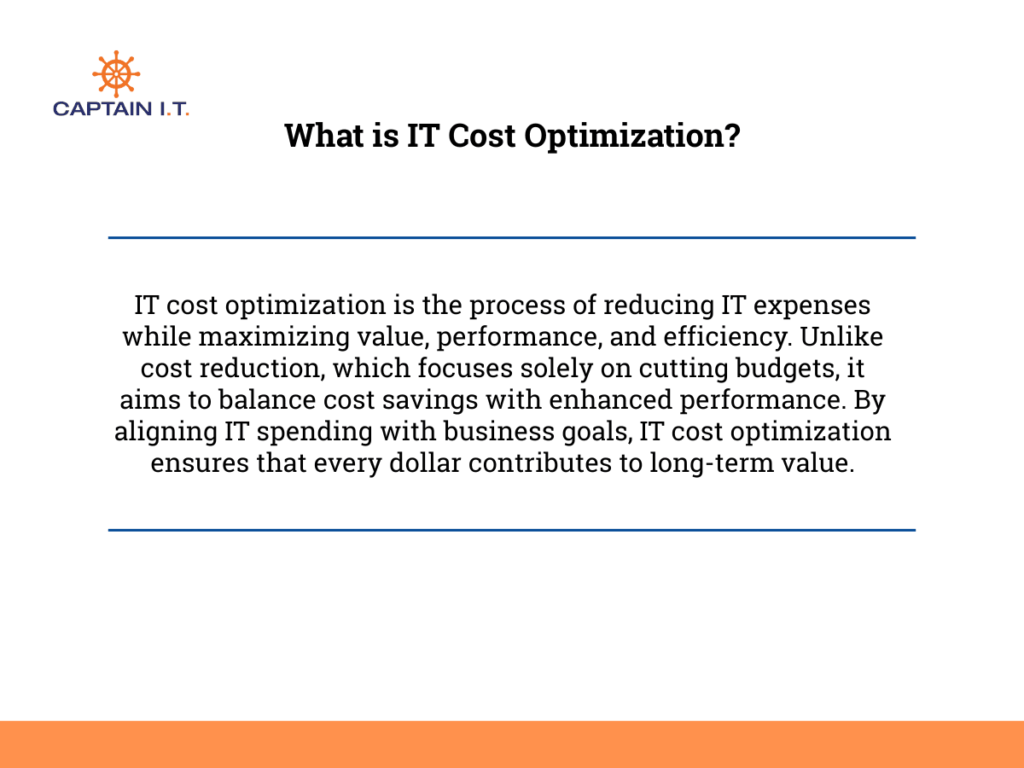
The key goals of IT cost optimization are budget alignment, resource efficiency, and cloud visibility. This involves identifying waste, such as underutilized cloud instances or redundant licenses, and eliminating it to improve cost-effectiveness. By optimizing cloud resources through right-sizing or consolidating unused licenses, businesses can better manage budgets while maintaining performance. This approach enhances IT leaders, CIOs, and decision-makers by improving flexibility and delivering long-term cost savings that support growth and resilience.
What are the IT Cost Optimization Strategies in 2025?
In 2025, IT cost optimization strategies focus on reducing waste, improving efficiency, and aligning technology spend with business goals. Key tactics include license optimization, cloud cost management, process automation, vendor consolidation, and resource pooling. These strategies help businesses eliminate redundancy, optimize cloud usage, and streamline operations to achieve better cost control and enhanced performance. To achieve sustainable results, it is crucial to adopt a balanced approach that prioritizes long-term value over short-term cost cuts.
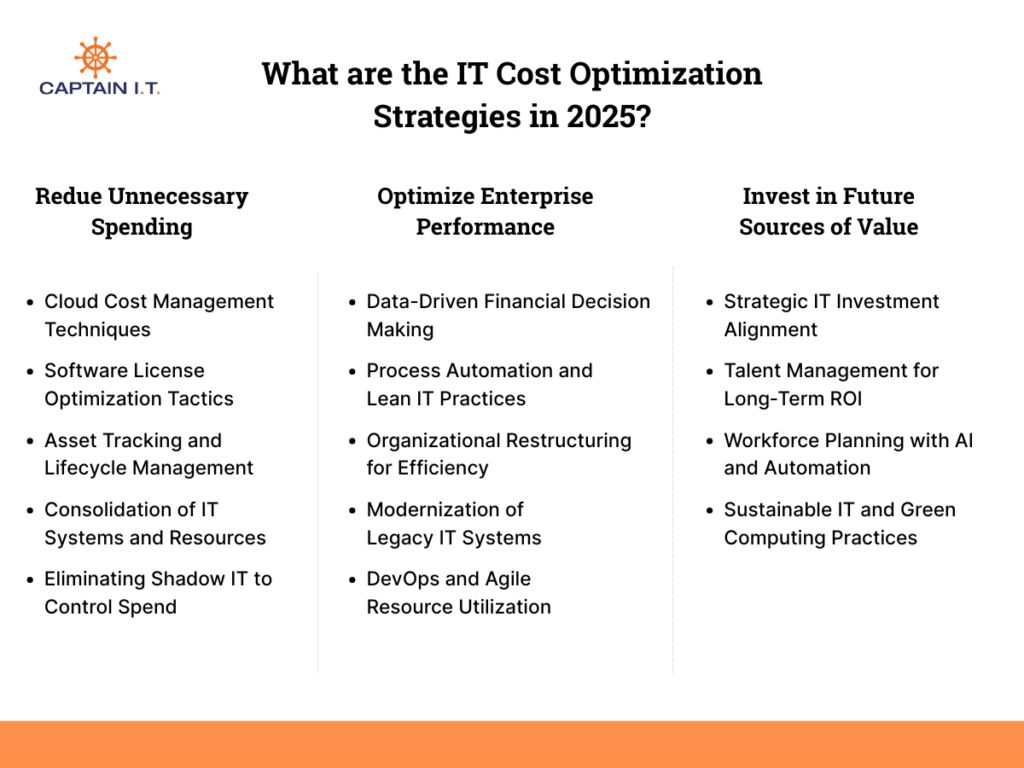
Reduce Unnecessary Spending
To reduce unnecessary IT spending, businesses can focus on cloud cost control, license optimization, asset tracking, and eliminating shadow IT. Right-sizing cloud resources, adjusting software licenses to actual usage, and consolidating unauthorized tools help lower costs. By regularly auditing and streamlining IT assets, businesses can reduce waste and reallocate funds to more impactful areas, improving overall efficiency and performance.
Cloud Cost Management Techniques
Optimizing cloud costs is essential for businesses to maintain financial efficiency and scalability in today’s dynamic IT environments. By applying effective cloud management techniques, companies can significantly reduce waste and improve resource allocation.
Key cloud cost management strategies include:
- Autoscaling to adjust resources based on demand and avoid overprovisioning
- Reserved instances for long-term savings on predictable workloads
- Shutting down idle resources to prevent unnecessary costs
- Monitoring data transfer costs to minimize expenses associated with data movement
- Continuous audits and FinOps adoption to track and optimize cloud spend on an ongoing basis
Software License Optimization Tactics
Effectively managing software licenses is a critical step in reducing unnecessary IT expenses and ensuring compliance. By optimizing license usage and eliminating waste, businesses can make the most of their software investments.
Some effective software license optimization tactics include:
- Automated license tracking to monitor usage and ensure compliance
- Adjusting license tiers to match actual usage and avoid overpaying
- Consolidating licenses to reduce the number of vendors and streamline management
- Regular compliance audits to identify unused or underutilized licenses
- Centralized license management to track and allocate licenses efficiently
Asset Tracking and Lifecycle Management
Managing the full lifecycle of IT assets is crucial for controlling costs and optimizing resource use. By effectively tracking and maintaining assets from acquisition to retirement, businesses can reduce waste and extend the useful life of their technology investments.
Below are the proven methods applicable for effective asset tracking and lifecycle management:
- Tracking hardware and software assets to ensure proper utilization and maintenance
- Implementing warranty-based refresh cycles to time upgrades effectively
- Utilizing a Configuration Management Database (CMDB) to centralize asset information
- Depreciation control to optimize the financial management of assets
- Recycling and repurposing old equipment to avoid unnecessary disposal costs
Consolidation of IT Systems and Resources
Consolidating IT systems and resources allows businesses to streamline operations, eliminate inefficiencies, and reduce overall costs. By unifying platforms, vendors, and processes, organizations can optimize their IT infrastructure and improve resource allocation.
Effective strategies for consolidation of IT systems and resources include:
- Vendor consolidation to reduce the number of suppliers and simplify procurement
- Platform unification to integrate systems and reduce the need for multiple tools
- Resource pooling to maximize utilization of existing assets and reduce waste
- Consolidating support teams to streamline IT service management and reduce staffing costs
- Centralized data management to improve collaboration and reduce storage duplication
Eliminating Shadow IT to Control Spend
By identifying and eliminating shadow IT, including unauthorized devices, applications, or services used within an organization, businesses can gain better control over IT spending and ensure that resources are used efficiently. Proper management of shadow IT can help prevent unforeseen expenses, inefficiencies, and security risks.
Key strategies for controlling shadow IT include:
- Shadow IT tracking to identify unauthorized devices and applications
- Usage visibility to monitor and manage applications across the organization
- Policy enforcement to establish clear guidelines for approved tools and services
- Employee training to ensure compliance with IT policies and prevent unauthorized usage
- SaaS discovery tools such as Torii, Zylo, and Youzer to uncover and manage hidden software solutions
Optimize Enterprise Performance
By adopting lean IT practices, DevOps methodologies, and modernizing legacy systems, businesses can optimize enterprise performance that helps boost operational efficiency while reducing long-term IT costs. As a result, business experience streamlined workflows, improved collaboration, and enhanced agility. Also, transitioning to cloud-native solutions and automating repetitive tasks helps reduce inefficiencies, improve scalability, and accelerate decision-making, resulting in both better performance and cost savings.
Data-Driven Financial Decision Making
Leveraging data for financial decision-making enables organizations to make smarter, more informed IT spend decisions. By utilizing predictive analytics and financial forecasting tools, businesses can gain deeper insights into their IT costs, enabling better budget allocation and performance tracking.
Key strategies for data-driven financial decision-making include:
- Predictive analytics to forecast future IT expenses and optimize resource allocation
- Expense vs. budget tracking to monitor spending against planned budgets
- Unit cost modeling to assess cost efficiency per workload or transaction
- Effective Savings Rate (ESR) to measure net cost reductions and ROI from optimization efforts
- Real-time financial dashboards to provide up-to-date insights for quicker decision-making
- Scenario analysis to evaluate the potential impact of different cost-saving measures
Process Automation and Lean IT Practices
Implementing process automation and lean IT practices is essential for businesses to achieve significant cost savings and operational efficiency. By automating repetitive tasks and eliminating inefficiencies, organizations can reduce manual errors, streamline workflows, and focus resources on high-value activities.
Key strategies include:
- Ticket handling to automatically categorize and assign requests
- Task automation to reduce manual effort and increase speed
- Lean methodology to eliminate inefficiencies and optimize workflows
- Robotic Process Automation (RPA) to automate routine tasks across IT operations
- IT service management (ITSM) automation to improve service delivery and reduce response times
- Standardization of processes to ensure consistent and efficient execution of tasks
Organizational Restructuring for Efficiency
Restructuring teams and IT processes can greatly enhance resource allocation and speed up decision-making. By realigning teams around business outcomes and adopting more agile frameworks, businesses can improve collaboration, reduce redundancies, and accelerate project timelines.
Effective approaches to organizational restructuring involve:
- Team realignment to ensure roles are aligned with business priorities
- Cross-functional delivery to improve communication and collaboration between teams
- Decentralized decision-making to empower teams to make quicker, more informed decisions
- Agile-based frameworks to streamline workflows and enhance flexibility
- Role clarity to eliminate overlaps and reduce inefficiencies
Modernization of Legacy IT Systems
Modernizing legacy IT systems is crucial for enhancing performance, reducing technical debt, and improving cost efficiency. By replacing outdated infrastructure with newer, more agile solutions, businesses can increase security, scalability, and speed while reducing long-term maintenance costs.
Some effective methods for modernizing legacy systems include:
- Cloud migration to replace on-premises systems with scalable, cost-efficient cloud solutions
- Containerization to increase flexibility and improve system portability
- API enablement to integrate legacy systems with modern applications and platforms
- Adopting a microservices architecture to enhance scalability and ease of updates
- Upgrading to modern platforms to reduce complexity and improve security
DevOps and Agile Resource Utilization
Leveraging DevOps and Agile methodologies, such as CI/CD pipelines and sprint-based planning, enables businesses to optimize IT resource deployment and accelerate project delivery. By promoting collaboration between development and operations teams, these methodologies help businesses streamline workflows and enhance resource utilization.
Examples of how to implement DevOps and Agile methodologies effectively include:
- Continuous Integration/Continuous Deployment (CI/CD) to streamline development and deployment processes
- Resource elasticity to scale resources dynamically based on workload demand
- Sprint-based planning to prioritize tasks and allocate resources effectively
- Automated testing and deployment to reduce manual intervention and speed up release cycles
- Collaboration tools to improve communication and accelerate project completion
Invest in Future Sources of Value
Investing in future capabilities drives long-term success and cost efficiency, as it focuses on building sustainable value rather than just cutting expenses. By investing in high-ROI initiatives like talent development, cloud readiness, automation, and sustainability, businesses can enhance growth while reducing future costs. Each investment should be assessed for ROI and alignment with strategic goals. Prioritizing areas like AI, cybersecurity, and scalable infrastructure ensures sustained value and improved operational efficiency.
Strategic IT Investment Alignment
Aligning IT investments with business objectives helps prioritize investments based on their strategic impact, ensuring that every dollar spent contributes to business growth. This approach focuses on selecting initiatives that directly support long-term goals and drive operational efficiency.
Strategies to align IT investments with business objectives include:
- Value-based prioritization to focus on projects that deliver measurable business outcomes
- Stakeholder alignment to ensure IT projects are in sync with organizational goals
- ROI forecasting to evaluate the financial return of each investment
- Regular review processes to adapt investments as business needs evolve
- Governance structures to maintain accountability and alignment with the business strategy
Talent Management for Long‑Term ROI
Investing in talent management plays a pivotal role in maximizing long-term IT efficiency and ensuring high ROI. By upskilling existing teams and fostering internal mobility, businesses can reduce hiring costs while improving employee retention and performance.
Key strategies for talent management include:
- Upskilling programs to enhance employee capabilities and reduce reliance on external hires
- Retention planning to foster employee loyalty and reduce turnover costs
- Cross-training initiatives to develop a versatile workforce that can adapt to changing needs
- Internal mobility allows employees to grow within the organization and fill skill gaps
- Performance-driven incentives to align employee goals with business outcomes
Workforce Planning with AI and Automation
AI and automation can revolutionize workforce planning by accurately forecasting demand and optimizing resource allocation. These technologies enable businesses to ensure staffing levels align with project needs, preventing both overstaffing and understaffing.
Strategies for integrating AI and automation into workforce planning include:
- AI forecasting models to predict staffing needs based on historical data and future trends
- Capacity planning tools, such as Saviom, Katana, and BigTime Foresight, to align workforce availability with projected demand
- Labor cost optimization by automating routine tasks and reallocating staff to higher-value activities
- Real-time analytics to adjust workforce planning in response to shifting business conditions
- Predictive workforce scheduling to optimize employee hours and minimize overtime
Sustainable IT and Green Computing Practices
Implementing sustainable IT practices is essential for reducing environmental impact, lowering energy costs, and enhancing overall operational efficiency. By focusing on energy-efficient technologies and minimizing waste, businesses can achieve significant cost savings while reducing their carbon footprint and contributing to a sustainable future.
Actions to implement green computing practices include:
- Energy-efficient hardware to reduce power consumption and lower operational costs
- Carbon-aware scheduling to optimize resource use based on environmental impact
- Hardware lifecycle extension to maximize the life of devices and reduce e-waste
- Eco-friendly cloud providers to choose data centers with sustainable practices
- Sustainable procurement to prioritize energy-efficient products and services
What are the Benefits of IT Cost Optimization?
IT cost optimization drives significant business value by improving IT efficiency, reducing operational costs, and enabling better resource management. By aligning IT investments with strategic business goals, organizations can boost profitability and long-term growth while minimizing unnecessary expenses.
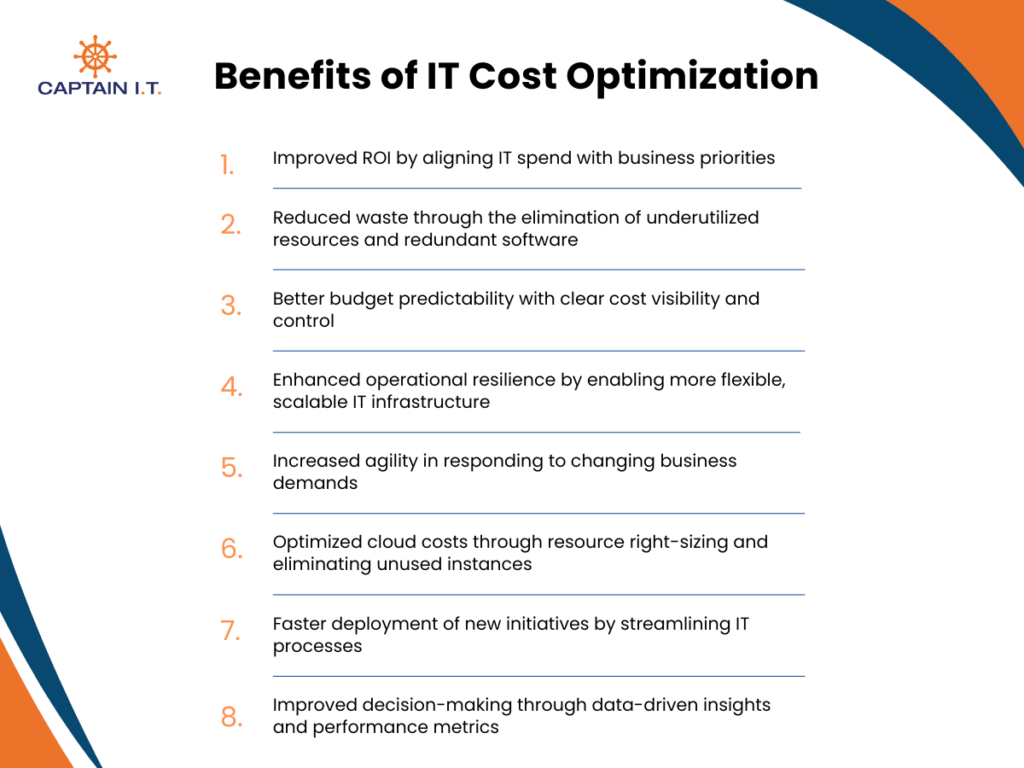
Key benefits of IT cost optimization include:
- Improved ROI by aligning IT spend with business priorities
- Reduced waste through the elimination of underutilized resources and redundant software
- Better budget predictability with clear cost visibility and control
- Enhanced operational resilience by enabling more flexible, scalable IT infrastructure
- Increased agility in responding to changing business demands
- Optimized cloud costs through resource right-sizing and eliminating unused instances
- Faster deployment of new initiatives by streamlining IT processes
- Improved decision-making through data-driven insights and performance metrics
For instance, a company that optimizes its cloud infrastructure and automates routine tasks can reduce cloud costs by up to 30% while accelerating the delivery of critical business projects. This leads to a quicker return on investment and a more agile organization that can adapt to market changes swiftly.
What are the Challenges Associated With IT Cost Optimization?
While IT cost optimization offers significant benefits, it can be difficult to achieve due to common challenges such as data visibility gaps, organizational resistance, and short-term decision-making. These barriers often prevent businesses from fully realizing the benefits of cost optimization strategies and hinder long-term success.
Some challenges associated with IT cost optimization are:
- Data visibility gaps make it difficult to track and manage IT spending accurately.
- Organizational resistance to adopting new cost optimization strategies.
- Short-term vs. long-term trade-offs, where immediate savings are prioritized over sustainable solutions.
- Tool redundancy leads to unnecessary costs and inefficiencies.
- Lack of ROI tracking prevents businesses from measuring the success of optimization efforts.
For example, a company might face challenges with tool redundancy, using several platforms that overlap in functionality, which results in wasted resources. Recognizing and addressing these blockers early leads to more sustainable optimization outcomes.
Measuring Cost Efficiency and ROI
To measure cost efficiency and ROI, businesses should focus on key metrics such as cost per workload, Effective Savings Rate (ESR), and cloud efficiency. These metrics help organizations evaluate the effectiveness of their IT investments, track resource utilization, and ensure that IT spending is aligned with long-term business goals, leading to improved profitability and cost savings.
Cost per Workload and Transaction
The cost per workload and cost per transaction metrics allow businesses to attribute IT costs directly to the output they generate, helping optimize resource allocation and cost efficiency. These metrics enable organizations to evaluate how much it costs to process each workload or transaction, providing insights into areas where spending can be reduced.
To calculate cost per workload, businesses measure the total cost of processing a workload, such as a virtual machine or application, and divide it by the number of workloads processed. This calculation includes infrastructure costs, such as cloud instances and storage, licensing fees for software, labor and support costs, and networking expenses related to the workload.
Cost per Workload = Total IT Costs for Workload / Number of Workloads Processed
Similarly, cost per transaction measures the cost of processing each transaction, such as an API call or user action. It includes the costs of the systems and infrastructure involved in processing the transaction, such as databases, cloud services, bandwidth, and support costs. This metric is particularly useful for environments with high transaction volumes, such as customer-facing platforms or cloud-based services.
Cost per Transaction = Total IT Costs for Transactions / Number of Transactions Processed
By measuring cost per workload and cost per transaction, businesses can:
- Identify inefficiencies in resource usage
- Optimize cloud and infrastructure costs based on actual usage
- Make data-driven decisions on scaling resources or optimizing processes
- Compare performance across teams, vendors, or platforms
- Adjust resource allocation to maximize value and minimize waste
Effective Savings Rate (ESR)
The Effective Savings Rate (ESR) is a key metric that measures the net savings a business achieves from its cost optimization efforts. It takes into account the actual savings after accounting for the costs of implementing optimization measures, providing a clearer picture of the financial benefits.
ESR = (Actual Savings – Optimization Costs) / On-demand Equivalent Spend
This formula helps businesses assess the true return on investment (ROI) of their optimization initiatives. Key elements of ESR include:
- Actual savings from reduced operational costs, such as cloud optimizations or resource pooling
- Optimization costs related to implementing the cost-saving measures, like software or consulting fees
- Total spend on IT-related expenses, including infrastructure, software, labor, and services
Tracking ESR allows companies to evaluate the effectiveness of their cost-saving strategies, ensuring that optimization efforts are delivering value and contributing to overall financial health.
IT Budget Allocation vs Utilization
Comparing IT budget allocation to actual utilization is essential for optimizing financial planning and ensuring that resources are used efficiently. This metric helps businesses identify discrepancies between planned spending and actual expenditure, providing insights into where budget adjustments may be necessary.
Key factors to consider when evaluating budget allocation vs utilization include:
- Allocation accuracy to measure how well the budget aligns with actual spending
- Underutilization to identify areas where allocated funds were not fully used or spent efficiently
- Reforecasting to adjust future budgets based on past performance and changing needs
- Showback and chargeback models to track departmental spending and ensure accountability
- Variance analysis to compare budgeted costs against actual expenses and identify areas for improvement
This analysis helps organizations make data-driven adjustments to their IT budgets, ensuring better resource allocation and cost control in future cycles.
Cloud Efficiency Metrics
Tracking cloud efficiency is vital for ensuring that businesses optimize their cloud resources and minimize unnecessary costs. By monitoring key performance indicators, organizations can identify areas of underutilization, reduce waste, and improve overall resource management.
Important cloud efficiency metrics include:
- CPU/RAM utilization to measure the efficiency of resource usage across workloads
- An idle resource ratio to identify unused cloud resources that can be scaled down or eliminated
- Right-sizing effectiveness to optimize the allocation of resources based on actual needs
- Cost per workload to evaluate the financial efficiency of each cloud service or instance
- Scaling efficiency to assess how well cloud infrastructure adjusts to varying workloads
Governance Models and Frameworks
Governance models provide the structure needed to manage IT costs effectively, ensuring accountability and alignment with business objectives. By adopting frameworks like FinOps and ITFM, organizations can better control their spending and improve resource allocation.
Governance models that help optimize IT costs include:
- FinOps to establish cloud financial accountability and optimize cloud spending
- IT Financial Management (ITFM) to enhance budget planning and improve resource distribution
- Policy-as-Code to automate policy enforcement and standardize decision-making processes
- Chargeback/Showback models to allocate IT costs to departments, ensuring transparency
- Unit economics to analyze the cost structure of IT services and maximize efficiency
These frameworks help businesses streamline cost management, align IT investments with strategic goals, and improve financial transparency across the organization.
Role of MSPs in Cost Optimization
Managed Service Providers (MSPs) help businesses reduce IT costs by offering specialized expertise without the need for full-time staffing. MSPs streamline operations through vendor consolidation, license management, and predictive analytics, while providing scalable solutions and 24/7 support.
MSPs contribute to cost optimization in several ways:
- Vendor consolidation to simplify vendor management and negotiate better terms
- License management to optimize software use and eliminate unnecessary licenses
- Predictive analytics to forecast IT expenses and align resources with business needs
- 24/7 support to reduce the need for in-house IT staff and ensure continuous service
- Automation to reduce labor costs and increase operational efficiency
Partnering with MSPs like Captain IT can provide businesses with flexible, cost-effective IT management solutions. Captain IT offers managed IT services across Southern California, helping organizations scale their IT operations, reduce overhead, and maximize the value of their technology investments. Our expertise in automation and cost forecasting ensures that your IT infrastructure is both efficient and sustainable.
